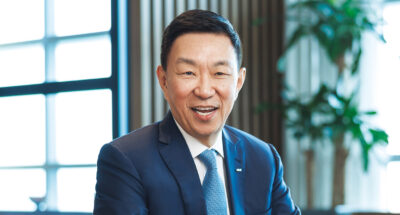Four years ago, as part of its digital transformation, the 127-year-old Swiss perfumes and flavors company Firmenich started d-labTM, an ambitious pilot project to develop its artificial intelligence capabilities and improve competitiveness.
However, unlike other companies that typically used AI to automate processes and used data to optimize supply chains or better understand their customers, Firmenich wanted to use AI to augment creativity. The result has produced the world’s first flavor produced with an AI algorithm. It has also halved the time it used to take the company to get a product to market.
Workplace creativity, a strategic corporate interest that is so often central to a company’s success, involves employees actively searching for new information that enables them to generate possible solutions to an identified problem.
But research suggests that it is difficult to maintain elevated levels of creativity over time, and that individual creativity often follows a curvilinear path that begins with an initial improvement followed by a long and gradual decline.
Against that backdrop, Firmenich’s journey highlights how a digital technology such as AI can help organizations and their employees not just in number-crunching exercises but also in ways that have until now been identified almost exclusively with quintessentially human skillsets. It also holds three important practical lessons for companies across a range of industries as they seek to harness and boost the creative process, sustaining it over time.
1. Top Management support
The first of these lessons centers on the importance of having a vision – and to count on strong sponsorship at the executive or board level to support it. In Firmenich’s case, the initial vision was simply to positively “disrupt” creativity rather than setting out a specific mission to use AI.
As Eric Saracchi, Firmenich’s Chief Digital and Information Officer, recalls, “Creativity is our core activity and differentiating factor, so this was our starting point to ask, ‘What do we do with creativity, and how can we augment our creative process?’.”
At first, there was considerable resistance to the idea, as it sounded far-fetched for users who were focusing on day-to-day issues and winning new business. But the project found a supporter in the form of Eric Nicolas, Firmenich’s Chief Financial Officer at the time, who provided strong executive support and sponsorship – and crucially, a budget allocated to the vision.
As Saracchi puts it, “We had a powerful CFO who believed in it, and who negotiated a deal to get the money and hire the best talents. Without that strong executive sponsorship, none of this would have gotten off the ground.”
2. Break with tradition
A second takeaway from Firmenich’s case is the importance of being different, and specifically being prepared to break the rules. Firmenich has a long and rich heritage in the perfumes and flavors industry, and the family-owned business has become one of the largest in the sector globally.
But the company also had many traditional policies at the time of its experiment with AI, including a legal prohibition on storing data in the cloud. It also had well-established ways of working, with clearly defined teams that often operated as silos.
To circumvent these obstacles, a pivotal decision was made: they moved the experiment out of their main offices to the Innovation Park at EPFL University, a hub and ecosystem that brings together academia and business to create innovative projects and help them grow.
“We realized it wasn’t going to work in our traditional office setup,” says Tarun Garg, digital strategist at Firmenich. “We needed to have a separate place where we could bring in people from different functions and divisions and instill an agile and innovation culture, and where we could have access to experts and students, professors and start ups. It was a condition for success.”
The separate physical space, which they called d-labTM, proved fertile ground for collaboration. Firstly, it put the executives in direct contact with other entrepreneurs as well as technology engineers. But it also acted as a neutral space in which Firmenich employees from different teams could meet and collaborate more effectively. “We could experiment and do new things without creating conflicts with the company operations,” Garg explains. “It allowed us to take more risk than would have been possible in the company but doing it in a calculated way.”
3. Balance long and short-term goals
The third takeaway from Firmenich’s use of AI in the creative process was to understand the importance of balancing long-term goals with short-term results. There was a buzz and high expectations about what AI could bring to the company. Yet, as the executives spearheading the project were aware, big expectations can take years to fulfil.
“We knew that somebody was going to start asking questions six months or a year down the road, so we basically knew that we had a honeymoon period of not more than 12 months,” recalls Philippe Glenat, then head of d-labTM.
Balancing delivery for the business in the short term with more ambitious long-term goals helped to keep people on board with the project. Specifically, the team kept a keen eye on potential use cases for the business, holding workshops with company employees to understand pain points, set expectations, and define a roadmap of functionalities that could contribute to the business in the shorter term.
To that end, the first solution d-labTM launched was not its AI formula generator – it was far simpler, but it had a clear impact: a Google-like search capability that allowed employees to sift through the company’s vast product portfolio and filter based on specific criteria.
“It was a useful business tool. It was also a catalyst to create more commitment and collaboration for the longer-term moonshot projects,” says Glenat.
On a path to augmented creativity
Today, d-labTM has managed to deliver on the longer term goals too: AI-based algorithms that can understand the olfactive profiling of ingredients and formulas, cost, and application constraints, and use all of that to create the most suitable perfume and flavor candidates from millions of historical formulae and more than 4,000 ingredients. This innovative approach has resulted in the world’s first AI-produced flavor – a lightly grilled beef taste for use in plant-based meat alternatives.
The company says it has boosted creativity within the organization, with the most advanced tools and technology to unleash their imagination, at speed and with accuracy. The Firmenich story is an example of how emerging technologies like AI can do more than finding an optimal solution to a defined problem; they can collaborate with humans to stimulate their intelligence, creativity, and learning.
But as Saracchi says, “It’s not the playbook, but the conditions we create that matter most.” It is also a reminder that technological experimentation can benefit from – and may even require – specific conditions to allow it to flourish.





